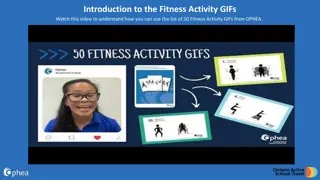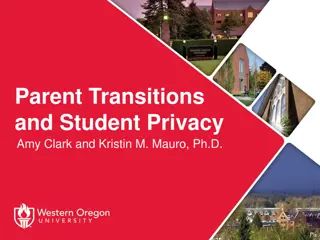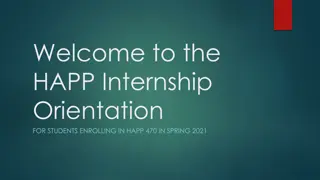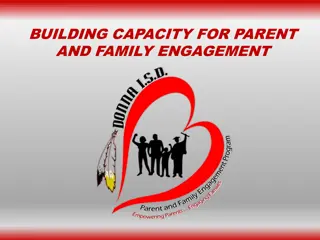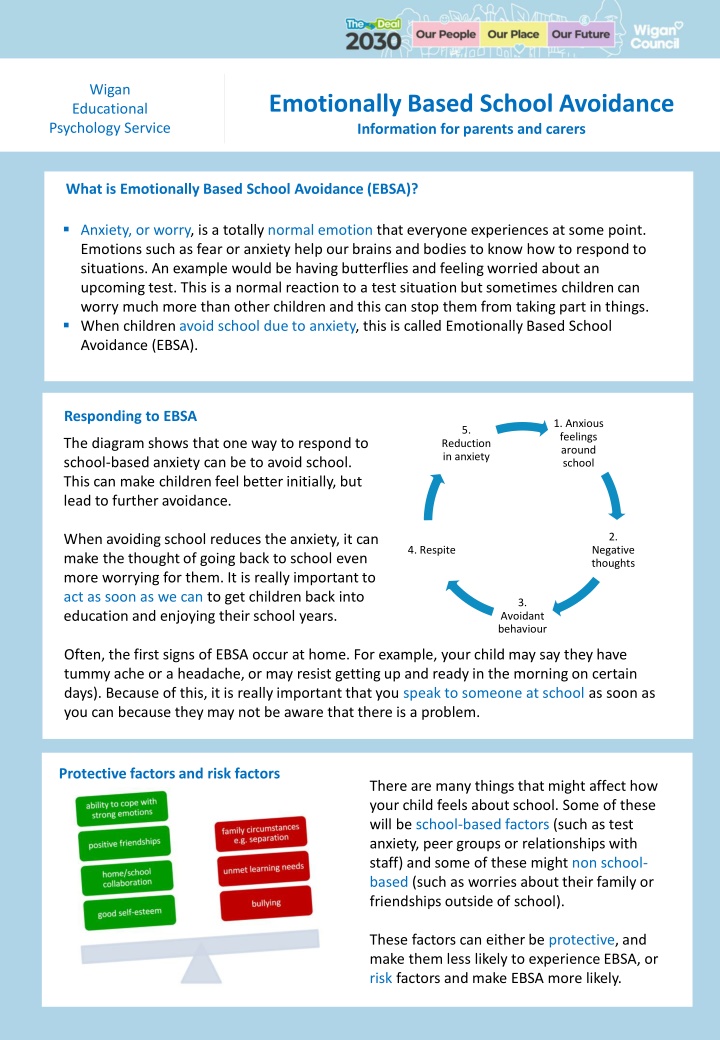
Emotionally Based School Avoidance in Children
Learn about Emotionally Based School Avoidance (EBSA), where children avoid school due to anxiety, and how parents and carers can identify and respond to it. Explore protective and risk factors, intervention strategies, and ways to create routines to support children in transitioning back to school.
Download Presentation

Please find below an Image/Link to download the presentation.
The content on the website is provided AS IS for your information and personal use only. It may not be sold, licensed, or shared on other websites without obtaining consent from the author. If you encounter any issues during the download, it is possible that the publisher has removed the file from their server.
You are allowed to download the files provided on this website for personal or commercial use, subject to the condition that they are used lawfully. All files are the property of their respective owners.
The content on the website is provided AS IS for your information and personal use only. It may not be sold, licensed, or shared on other websites without obtaining consent from the author.
E N D
Presentation Transcript
Wigan Educational Psychology Service Emotionally Based School Avoidance Information for parents and carers What is Emotionally Based School Avoidance (EBSA)? Anxiety, or worry, is a totally normal emotion that everyone experiences at some point. Emotions such as fear or anxiety help our brains and bodies to know how to respond to situations. An example would be having butterflies and feeling worried about an upcoming test. This is a normal reaction to a test situation but sometimes children can worry much more than other children and this can stop them from taking part in things. When children avoid school due to anxiety, this is called Emotionally Based School Avoidance (EBSA). Responding to EBSA 1. Anxious feelings around school 5. The diagram shows that one way to respond to school-based anxiety can be to avoid school. This can make children feel better initially, but lead to further avoidance. Reduction in anxiety 2. When avoiding school reduces the anxiety, it can make the thought of going back to school even more worrying for them. It is really important to act as soon as we can to get children back into education and enjoying their school years. 4. Respite Negative thoughts 3. Avoidant behaviour Often, the first signs of EBSA occur at home. For example, your child may say they have tummy ache or a headache, or may resist getting up and ready in the morning on certain days). Because of this, it is really important that you speak to someone at school as soon as you can because they may not be aware that there is a problem. Protective factors and risk factors There are many things that might affect how your child feels about school. Some of these will be school-based factors (such as test anxiety, peer groups or relationships with staff) and some of these might non school- based (such as worries about their family or friendships outside of school). These factors can either be protective, and make them less likely to experience EBSA, or risk factors and make EBSA more likely.
Together our job, as parents, carers and adults supporting you and your child, is to try and work out what the risk and protective factors are. We can then use the protective factors as strengths to build upon, and to put a plan in place to address the risk factors. The diagram below shows examples of how these factors can seem to pull children towards either home or school. A really important part is working together with the aim of pulling the child towards school (rather than towards home): Pull to HOME Pull to SCHOOL Playing computer games Good friendships Worries about a family member Enjoys a lunchtime club Confident in arts Avoidance of school work What can we do to help? The good news is that there is lots that can be done! The triangle below shows the different levels of work that can be done. Imagine it like a tower of blocks we work from the bottom up, with the foundations needing to be in place for the top two levels to be effective. The top two levels, group and individual intervention, are likely to occur at school and be supported by professionals. Individually tailored modifications Group intervention e.g. social skills Safety, boundaries, connectedness, culture of celebrating attendance That is why parents and carers are so important in supporting children with EBSA . For any intervention to work, children need the aspects in the bottom level, at home and at school. When children are at school, the routine is very set, they follow a timetable and there are accepted school and class rules. The nature of home life isn t as set in stone! That means it s really important that, if your child isn t currently attending school, they still have a routine. For example, this might mean getting up at the normal time for breakfast, doing some online learning, having lunch at the same time, going for a walk or doing some exercise, and then working on a project in the afternoon. These boundaries will make it much easier for them to transition back into school routines and work to break part of the avoidance cycle.
Working together Research into EBSA suggests that one of the biggest factors in successful reintegration to school is professionals working alongside parents in partnership. Together, a firm, consistent approach must be planned and agreed. This should take account of your child s strengths and talents, as well as identifying and supporting their needs at home and at school, alongside the needs of the family and school. If a child has started avoiding school, or aspects of school, it s essential that a plan is solution focused. Key characteristics of effective plans are that they work towards the child s longer-term goals and that small, meaningful steps are agreed as outcomes. For example, to build a build back up to coming into school you may co-create and agree the following plan which starts with: ...parent walks pupil up the path to meet adult, pupil spends half an hour in wellbeing activities... ...trusted member of staff walks child up the path with parent, walk around school together... ...trusted member of school staff chats with pupil in car... ...parent builds up to driving to school and parking outside... ...parent builds up to getting pupil in the car... Parent establishes routine e.g. putting uniform on... Managing emotions Going back to the cycle of avoidance, our job is to help children to manage the difficult emotions that they feel, in a more helpful way than avoidance. Many young people can find this really challenging because facing a problem is often much more difficult that ignoring it, yet it s a skill we must all learn for preparing for adulthood. Going back to the cycle of avoidance, our job is to help children to manage the difficult emotions that they feel, in a more helpful way than avoidance. Many young people can find this really Remember that your child is likely to be finding it hard to manage the strong feelings they have, and that s ok! As parents and the adults supporting your child, we can coach them through this and to help them to learn how to manage these feelings. Involvement from more specialist services Some children may have been referred for assessment from other professionals such as the Child and Adolescent Mental Health Service (CAMHS) or from the Educational Psychology Service (EPS). If so, these appointments are very important. Going back to the cycle of avoidance, our job is to help children to manage the difficult emotions that they feel, in a more helpful way than avoidance. Many young people can find this really strategies. It will be important that these strategies are shared because your child will need help from you to practice and use these strategies in real life situations. There are strategies to use alongside work from other professionals and when waiting for appointments The CAMHS practitioner or psychologist may work with your child to help them to develop
What can I do at home? Keep the conversation about school open, even if it's difficult. Reassure that it s ok to feel worried. It s a normal emotion that is temporary. We can work together to make the situation better. Talk about the positives or things they miss, such as seeing friends or a club. Strategies to use now Remind them of their aspirations, and that talking and thinking about school is one step towards this. Watch their body language, listen. What are they saying? How are they feeling? Be non- judgemental, we need them to feel safe to talk about feelings. Where can I find out more? For more information about emotional wellbeing and how to support your child, the following resources may be helpful: Wigan Family Welfare offer counselling and parent/young person advocacy service. www.youngminds.org.uk (provides information online, including a page on school refusal ) www.mind.org/information-support/for-children-and-young-people (lots of information online) www.wigan.gov.uk/LINC2/survival-guide/survival-guide (information and advice from young people and professionals and a guide to local services in Wigan) Stuff That Sucks: Accepting what you can t change and committing to what you can. Book by Ben Sedley. https://book.languageoflistening.com (A really free e-book which talks through how to coach emotions.










